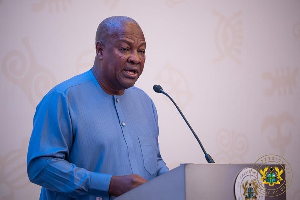Since the May 2019 MPC meeting, global growth momentum has continued to decline, reflecting heightened policy uncertainty on a number of issues, including escalated trade tensions between the US and China, unresolved Brexit negotiations, and geopolitical tensions. In emerging market and developing economies, growth broadly weakened, influenced largely by the slowdown in global trade and concerns on the back of the on-going US-China trade tensions.
Inflationary pressures in advanced economies, including Ghana’s key trading partners, remain relatively subdued as a result of low energy prices and sluggish wage growth, despite the tightening of labour markets. Across emerging market and developing economies, the recent drop in oil prices have contributed to subdued inflation pressures. In the outlook, inflation is forecast to remain stable in advanced economies due to the expected moderation in global growth, relatively anchored inflation expectations, and moderate wage growth. The expected drop in oil prices and dovish shift in central bank forward guidance in most advanced economies are expected to keep interest rates low and support growth over the medium term. Global financing conditions, on the other hand, have eased somewhat due to prospects of anticipated cuts in the US Fed rate in the second half of the year, and the general accommodative
Monetary policy stance across most advanced economies. Accordingly, global interest rates are likely to remain broadly unchanged and in some cases decline and support a reverse-flow of capital to emerging markets and frontier economies with strong fundamentals, and also limit the risk of sudden portfolio reversals from emerging market and developing economies.
The momentum in domestic economic activity continued to pick up, evidenced by the latest growth estimates released by the Ghana Statistical Service. The first quarter GDP annual growth was estimated at 6.7 percent compared with 5.4 percent in the same period of last year. Non-oil growth was strong at 6.0 percent, up from 4.2 percent recorded for the corresponding period of 2018. The growth outturn was driven by a strong recovery in the services sector which grew by 7.2 percent compared with 1.2 percent in 2018.
The Bank’s updated Composite Index of Economic Activity (CIEA) also reflected strong uptick in economic activity. The updated CIEA recorded a growth of 3.2 percent year-on-year in May 2019, compared with a 2.2 percent growth during the same period last year. Consumer confidence also picked up significantly reflecting optimism about current and future economic conditions, while business sentiments softened somewhat.
Headline inflation has trended downwards since April 2019 after three consecutive price increases on the back of exchange rate pass-through effects. From 9.5 percent in April, inflation declined to 9.4 percent in May, and further to 9.1 percent in June. Underlying inflation also trended downwards as the Bank’s main measure of core inflation (inflation excluding fuel and utilities prices) eased in June 2019.
The country’s three main export commodities — oil, gold and cocoa— traded mixed in June 2019. Crude oil prices rebounded during the first five months as production cuts coupled with renewed geopolitical tensions lifted prices. However, prices have since moderated to an average of US$63.1 per barrel in June, down from an average of US$71.0 per barrel. On the other hand, gold prices made significant gains as the US-China trade tensions heightened. Gold prices rallied to a six-year high average of US$1,359.7 per fine ounce in June 2019. Prices of cocoa bounced back in June, driven by supply constraints. The recent move by Cote d’Ivoire and Ghana to set a floor price for cocoa also supported the price rally. Cocoa prices averaged US$2,467.1 per tonne in June.
Consequently, export receipts for the first half year remained robust at nearly US$8.0 billion and together with a relatively lower import bill, positively impacted on the trade account. Provisional trade balance for the first half of 2019 recorded a surplus of US$1.9 billion (2.8% of GDP), compared to a surplus of US$1.3 billion (1.9% of GDP) in the first half of 2018.
The trade surplus was partly offset by net outflows in the services and income accounts, leading to a marginal current account surplus of US$39 million (0.1% of GDP) in the first half of 2019 compared to a deficit of US$409 million (0.6% of GDP) in the same period last year. The current account surplus, though marginal, is the first in recent history. This surplus, together with significant inflows to the capital and financial account, yielded an overall balance of payments surplus of US$1.3 billion (1.9% of GDP) over the review period, compared with a deficit of US$372 million (0.6% of GDP) last year.
Gross International Reserves (GIR) stood at US$8.6 billion (equivalent to 4.3 months of import cover) at the end of June 2019 up from US$7.0 billion (equivalent to 3.6 months of import cover) at the end of December 2018.
The domestic currency market has remained relatively calm. The Ghana Cedi cumulatively depreciated by 8.2 percent in the year to July 18, 2019, compared with 5.8 percent for the corresponding period of 2018. Against the British pound and Euro, the Ghana cedi cumulatively depreciated by 5.9 percent and 6.5 percent respectively, compared with 2.5 percent and 2.9 percent depreciation respectively over the same corresponding period. In trade-weighted terms, the real effective exchange rate continued to be broadly aligned with the underlying fundamentals.
Provisional data for the first five months of 2019, showed an overall budget deficit (on cash basis) of 3.0 percent of GDP against the target of 2.4 percent of GDP. This excludes some legacy energy-related payments of about 0.7 percent of GDP The higher-than-projected fiscal deficit outturn was primarily driven by lower-than-expected revenues outturn against increased pace of spending. The revenue shortfalls were mainly from international trade taxes. Over the review period, total revenue and grants amounted to GHc18.5 billion compared to a programmed target of GHc21.5 billion, indicating an annual growth of 7.6 percent. Total expenditures however reached GHc28.6 billion, marginally below the target of GHc29.7 billion, and representing 25.2 percent annual growth.
In line with the above developments, the stock of public debt rose to 58.1 percent of GDP (GHc200.0 billion) at the end of May 2019 compared with 51.0 percent of GDP (GHc153.4 billion) at the end of May 2018. Of the total debt stock, domestic debt was GHc94.6 billion (27.5% of GDP), of which GHc11.0 billion (or 3.2% of GDP) represented bonds issued to support the financial sector clean-up while external debt was GHc105.4 billion (30.6% of GDP).
Business News of Monday, 22 July 2019
Source: goldstreetbusiness.com













